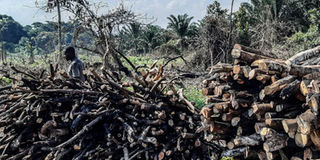RDC, forestry officer clash over illegal tree cutting

Deforestation. A man assembles firewood in Funve Central Reserve in Mazinga Sub-county, Kalangala District recently. PHOTO | FILE
What you need to know:
- The Kalangala Resident District Commissioner accuses forestry officer of forging signatures to allow illegal logging in the island district.
The Kalangala Resident District Commissioner (RDC), Ms Eva Kwesiga and the District Forest Officer, Mr Joseph Byaruhanga, have locked horns over illegal logging.
Ms Kwesiga on Tuesday accused officials from the district forestry department of forging her signature to permit illegal logging in private forests.
In the August 17 letter to Mr Byaruhanga, Ms Kwesiga expressed her frustration, saying: “It’s to my dismay that an officer from [your] office has been busy forging letters with my signature, which is very absurd.”
Ms Kwesiga said the district security committee, which she heads, last week sat and permitted four private forest owners to cut down trees. To her surprise, she received information that other foresters not known by her office, also got clearance to carry out logging, with letters bearing her forged signature.
“After getting original letters from my office, government workers and the district security committee sat on their desks and replaced names of those cleared with other timber dealers we did not clear,” she said.
But Mr Byaruhanga denied the allegations, saying: “I am not aware of anyone from this office who has any letters with the RDC’s forged signature. Also, I didn’t know that now it’s the office of the RDC to authorise cutting of trees or issuance of timber harvesting licences and movement permits.”
However, the RDC said Mr Byaruhanga risks arrest if her signature continues to be forged on documents authorising cutting and transportation of timber in the district.
“If I see any other letter with my forged signature, I will defiantly order his arrest,” she said.
The involvement of the office of the RDC in matters concerning tree cutting and transportation is based on the implementation of the presidential directive that banned these activities for commercial purposes to reduce the environment degradation across the country.
In the May 24 Executive Order No.3, President Museveni guided that only factories processing timber within Uganda for production of plywood, furniture and other value-added products, should be allowed to operate, but with sustainable tree planting and harvesting plans.
In Kalangala, private foresters are currently required to apply if they so wish to cut trees in their forests and the letter has to show acreage, with a signature of the village chairperson.
The RDC, district internal security officer, district forestry officer, a representative from the office of the chief administrative officer, National Forestry Authority, and the district police commander, are expected to first inspect the forest where tree cutting is to take place.
To manage truckloads of timber out of Kalangala islands, the district security committee resolved that the transporter must obtain clearance letters signed by the RDC, district internal security officer and the district forestry officer.
Several forests in the district have been replaced with palm oil plantations and rice gardens, while several businessmen have invested in illegal timber cutting business. Available statistics indicate that of the 31 forest reserves in the area, 17 of them have been depleted. A December 2017 report by Ssese Islands Nature Conservation and Tourism Association showed that 60 per cent of Kalangala’ s forest cover had been destroyed between 2014 and 2016 for timber, charcoal and rice growing.
The report titled, “The future of Kalangala’s forest cover”, also indicated that although many people had cut down trees for palm oil, the biggest reason for cutting down forests was because many of the fishermen were rendered jobless by the ongoing operation against illegal fishing.
Large chunks of forests have in the past been cut down in Kalangala to pave the way for commercial agriculture. In early 2002, the district lost more than 20,000 acres of forests to oil palm cultivation.




